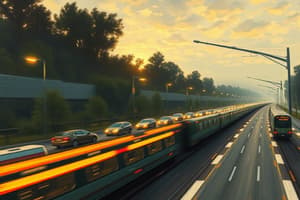Podcast
Questions and Answers
What does the field of study of a Contemporary Economic Geographer entail?
What does the field of study of a Contemporary Economic Geographer entail?
Study of the spatial patterns and processes that shape economic activities and their impact on the environment and society.
What is the significance of Purchasing Power Parity (PPP) in comparing economies globally?
What is the significance of Purchasing Power Parity (PPP) in comparing economies globally?
PPP adjusts for differences in the cost of living between countries, enabling more accurate comparisons of economies.
How did the emergence of flexible manufacturing change the industry from its Fordist origins?
How did the emergence of flexible manufacturing change the industry from its Fordist origins?
Flexible manufacturing introduced more adaptable and specialized production, replacing Fordist mass production and deskilling of labor.
What are the limitations of Gross Domestic Product (GDP) as a measure of a country's wealth?
What are the limitations of Gross Domestic Product (GDP) as a measure of a country's wealth?
What are the key factors that contributed to de-industrialization in the manufacturing sector?
What are the key factors that contributed to de-industrialization in the manufacturing sector?
What are the fundamental differences between the fields of Economics and Economic Geography?
What are the fundamental differences between the fields of Economics and Economic Geography?
What are the key characteristics of Subsistence, Commercial, and Planned economies?
What are the key characteristics of Subsistence, Commercial, and Planned economies?
What is the significance of trademarking in wealth creation?
What is the significance of trademarking in wealth creation?
What are the main differences in the transportation of goods compared to people?
What are the main differences in the transportation of goods compared to people?
How has human transition contributed to the development of the modern day world?
How has human transition contributed to the development of the modern day world?
What are the main categories of economic activity?
What are the main categories of economic activity?
What is the significance of Purchasing Power Parity (PPP) in comparing economies globally?
What is the significance of Purchasing Power Parity (PPP) in comparing economies globally?
What are the key characteristics of Corporate Farming as a model of agricultural production?
What are the key characteristics of Corporate Farming as a model of agricultural production?
What are the limitations of GDP and GNP as measures of a country's wealth?
What are the limitations of GDP and GNP as measures of a country's wealth?
Flashcards are hidden until you start studying
Study Notes
Exam Questions and Topics
- Past test questions for GEOV211: Economic and Development Geography
- Topics include Contemporary Economic Geography, comparing economies globally, flexible manufacturing, and more
Economic Geography
- Defined as a sub-discipline that studies economic systems and activities within a geographic context
- Examines the spatial organization of economic activities and their relationships with the environment and society
Comparing Economies Globally
- Difficulties include differences in economic systems, institutions, and cultural contexts
- Purchasing Power Parity (PPP) is a method used to compare economies globally by adjusting for price differences
Flexible Manufacturing
- Emerged as a response to Fordist mass production methods
- Characterized by flexibility, adaptability, and customization in production processes
Economic Systems
- Three types typically found in the late 20th Century: Subsistence, Commercial, and Planned economies
- Each type has unique characteristics and features
Gross Domestic Product (GDP) and Gross National Product (GNP)
- Both are measures of a country's wealth, but have limitations and drawbacks
- GDP measures domestic production, while GNP measures national income
De-industrialization
- A process of decline in manufacturing industries, leading to job losses
- Factors contributing to de-industrialization include globalization, technological change, and shifts to service-based economies
Renewable and Non-Renewable Resources
- Renewable resources can be replenished naturally, while non-renewable resources are finite
- Examples of renewable resources include solar, wind, and hydro power
Economic Development
- Development needs to happen sustainably, considering environmental and social impacts
- Trademarking is important for wealth creation, as it protects intellectual property and promotes innovation
Studying That Suits You
Use AI to generate personalized quizzes and flashcards to suit your learning preferences.




